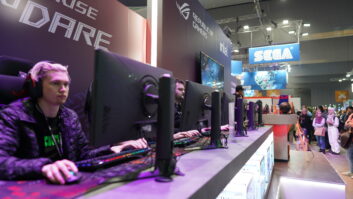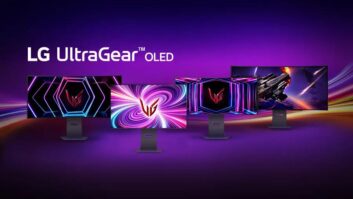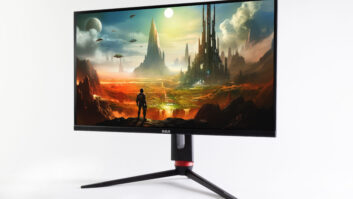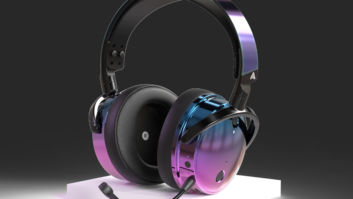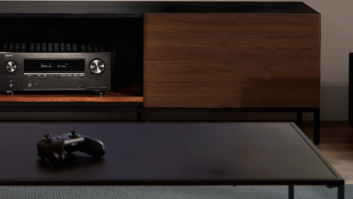LAS VEGAS —
Looking back years from now, 2010
will be seen as a halcyon year in video gaming history
thanks to three disparate developments: the introduction
of the gesture-based Sony Move and Microsoft
Xbox 360 Kinect, 3D HDTV, and the rise of
iPod/iPhone and Android devices as prominent mobile
gaming platforms.
While devices and games within these three literal
game-changing paradigm shifts will attract a lot of attention,
accessories and new games for more traditional
PC, console and mobile gaming, as well as the
suddenly market noisy music-based gaming category,
will be on display on the show floor. More than 40
gaming companies are gathered in the 9,800-squarefoot
International CES Gaming
Showcase in the North Hall.
“With the gaming market expected
to generate $20.3 billion
in 2010, the International CES is
the must-stop hub for innovative
gaming products,” said Karen
Chupka, CEA’s events and conferences
senior VP.
But most attendee eyes — and
arms — will be focused on gesture-
based gaming at the Sony
and Microsoft booths. After 16
years, Nintendo also returns to
CES, albeit in meeting rooms
rather than a booth.
“We really predict the star of
the show will be VR or AR [Virtual
Reality or Augmented Reality],”
agreed Dave Halas, gaming analyst for the New England
Consulting Group, “now that the big three have
their gesture technology in place. And we suspect other
players will come in to piggyback on the success of
the Kinect and the Move.”
How are the Kinect and the Move moving? Robustly.
At press time, Sony had reported it had moved 4.1 million
Moves in its first 10 weeks of availability, while Microsoft
said it has sold 2.5 million Kinects worldwide
in less than a month.
“The Kinect is likely to steal ground from Wii,”
opined Pietro Macchiarella, Parks Associates, gaming
research analyst. “For the first time, Wii is now in third
place behind PS3 and Xbox. The Kinect targets the
same demo as the Wii — people who are less hardcore
gamers. Move is aimed more at core gamers.”
At press time, Microsoft was unable to supply details
about what it’d be showing off Kinect-wise in its booth,
other than confirming the Kinect would be on display.
But at the Sony booth, “we’ll be showing off a number
of our 2011 software titles, some of which incorporate
PlayStation Move, stereoscopic 3D or a combination
of both,” hinted Jon Koller, hardware marketing
director for Sony Computer Entertainment of America
(SCEA). “We’ll have a number of kiosks set up in our
booth to show Move titles and more, and there will be
developers on hand to talk about the games as well.”
With Move and Kinect joining Wii, gesture-based
gaming is getting a boost that could spread gaming
beyond its clichéd teenage boy base.
“Gesture brings in a wider variety of games outside
of fun, such as Wii Fit, that skew more toward older
and female than the other consoles,” said Halas, “a
new demographic segment that would never pick up a
video game controller.”
Unlike traditional gaming, gesture-based titles need
a bit more demonstration — and, therefore, a bit more
retail floor space to accommodate wildly gesticulating
gaming customers.
“Retailers can’t do those end-shelf displays,” explained
Halas. “They will have to dedicate some more
space. As gesture technology develops, we should
expect to see retailers deeming it valuable to devote
retail space to demonstration, since the demonstration
proves their worth.”
Koller countered, “Move doesn’t require a whole lot
more space than a typical interactive gaming kiosk. But
because the player is often engaged with the game in
a new and unique way, we have worked with retailers
to ensure a comfortable game-play experience. We
also have a number of more living room style environments
at select retailers, which
provide consumers an example
of how PlayStation Move could
be set up in their home.”
The success of the Move
and Kinect also may breed new
game-specific accessories. “Accessories
and add-ons would
out-weigh the cost of the game
undoubtedly,” Halas noted. “The
industry is largely reliant on intense
gamers, who would spend
$100 on accessories for a $60
game.”
Interestingly, both Move and
Kinect are more or less accessories
to the PS3 and Xbox 360
consoles. As a result, Sony and
Microsoft “will be able to extend
the life cycle of these products,” Macchiarella observed.
“Both Microsoft and Sony now expect a lifecycle
of 10 years for PS3 and Xbox.”
Since the PS3 is the lone 3D gaming console, 3D
gaming may develop slower than the suddenly crowded
gesture-based market.
“The complexity in the programming and design of
a full-length 3D game — that’s a major task,” observed
Halas. “They wouldn’t want to put out a 3D game if it’s
inferior in game play or realism. They need to take a
couple of years before the technology for the games
can support the quality the publishers are seeking.”
There’ll be a lot more happening in 3D on the PC
gaming side. Just before CES, Nvidia (South Hall
31431) unveiled 3DTV Play software, which not only
turns more than 500 regular 2D PC games into 3D,
but lets consumers play them on any 3D HDTV when
its connected to one of the growing number of HDMIconnected
Nvidia GeForce-equipped laptop PCs. Exhibiting
GeForce laptop makers include Dell, Hewlett-
Packard, Toshiba and Asus.
A list of convertible 2D games is available on Nvidia’s
website and the game packages themselves will
be marked “3D Vision Ready.”
Without meaning to, Apple’s iPod/iPhone/iPad iOS
operating system has become a leading mobile video
game platform in the U.S. According to a recent survey
by market research company Newzoo, iOS and Nintendo
each has a bit more than 40 million players in the
U.S., with PSP around 18 million. And market research
firm Interpret says mobile phones now make up 43.8
percent of the mobile gaming market.
In reaction, both Sony and Nintendo are likely to
launch new mobile game devices. Sony may or may
not unveil the PSP2, reportedly due in late 2011, and
may or may not show the iPhone-like Sony-Ericsson
Zeus Z1 PlayStation phone, which reportedly could go
on sale as early as next month. At press time, Sony declined
to comment on either product. Nintendo is likely
to show off its long-gestating 3DS, the company’s
glasses-less 3D portable.
At CES, Sony and Nintendo are likely to have the
mobile gaming platform to themselves since Apple
has never exhibited at the show, and Android game
developers will likely concentrate on the CTIA show in
Orlando two months from now.





